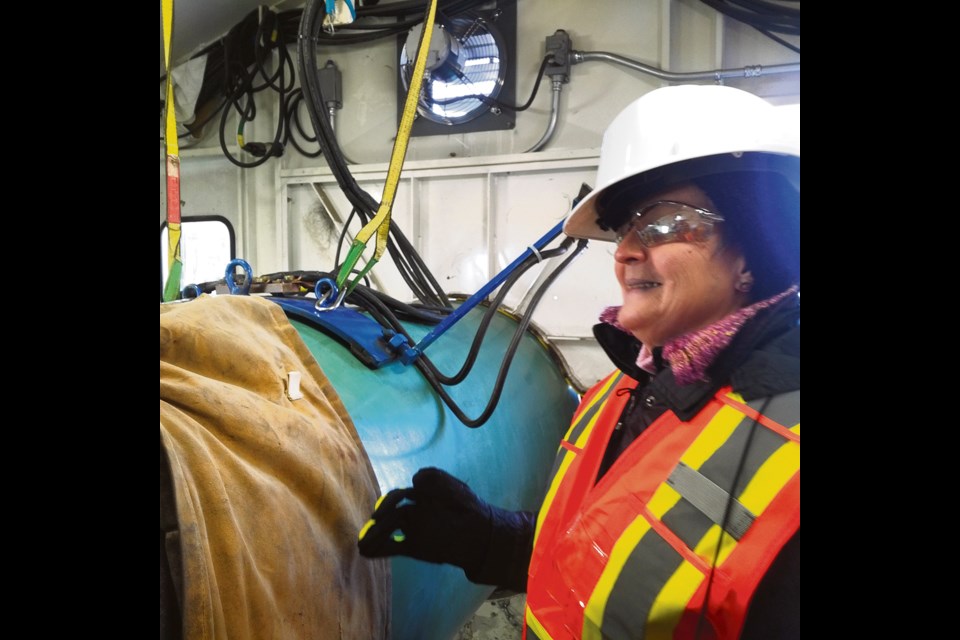Outfitted with orange vests, white hardhats and gloves with glow green knuckles, local officials, land owners and the media toured the construction process on Enbridge Line 3 Replacement project on Oct. 12.
“If you do happen to smoke, please take your butts,” said tour guide Joanne Bradbury before the group of 30 left Wawanesa hall. “We don’t leave anything on the right-of-way.”
Passing Bannister work crews, the tour began at a Sommerville-Aecom (SA Energy) site.
Amid the gentle roar of machinery punctuated by back-up warning beeps we witnessed a process designed to treat the pipe with better care than many would treat their grandmother’s silverware.
From Hardisty, Alta. Line 3 replacement runs in a pipeline corridor along with seven other lines, travelling south of Virden on its journey to Gretna in southern Manitoba. From that point it enters through a corner of North Dakota, into Minnesota (approved there in June, 2018), and on to the super terminal at Superior, Wisconsin.
Spread 7 brings the line from the RM of Maryfield, Sask. into Manitoba through the corner of the RM of Wallace-Woodworth, eastward through Pipestone, Sifton, Souris-Glenwood, into the RM of Wawanesa-Oakland, where Spread 8 begins.
Awaiting installation, the pipe had to be white-coated as it sat out through a lengthy regulatory process that began in November four years ago. In the meantime, for safety, Enbridge reduced the pressure on the old Line 3 to run at about half its potential.
Waiting on wildlife
Before the pipe was laid out, the topsoil was stripped off the right-of-way and stock-piled. Highly visible deep green bio-degradable cellulose sprayed along the edge of the right-of-way provides a boundary for the precious topsoil, guarding against contamination.
The transitional soils as well as the deeper clay bedding is also stockpiled separately.
Aquatic or riparian lands require extra care. In some cases, directional drilling or direct boring takes the pipe under a creek or river bed.
An environment team sweeps the right-of-way to ensure that rare plants and birds are not harmed.
Construction was delayed this August for conservation reasons. An endangered bird, a bobolink was in the way. Mr. and Mrs. Bobolink hadn’t quite got the kids out of the nest this August, so construction did not go ahead until nesting was over.
Moving along the multi-line corridor, using a hydro-vac, tests are made to check that the existing pipes are mapped accurately within the line.
Tour guide Assistant Construction Manager Mike Jespersen pointed to data recorded on a yellow stake, showing a pipeline in the ground, buried 2.2 metres below the surface.
Welding process
To join the 20-metre lengths of pipe, an internal clamp expands and holds the two pipes together while the weld is made. The internal joiner scuttles down through the length of pipe on little wheels to each new join.
Five portable welding ‘shacks’ chug along the length of pipe in tandem, each one adding a layer of weld, which Jespersen explains as “The root, the hot pass, three fills and then a cap on top of that as well.”
Every join is registered into GPS data showing when the weld was done. In addition, data is written on the pipe in case it is ever dug up for repair.
Radiography and x-rays are performed to check each weld.
“Right now, our repair rate is between one and two percent,” said Jespersen. “We’re close to about 2800 welds right now, on this spread.”
The pipe follows the contours of the land, so it must be bent slightly at hills and hollows. It is inspected again and any repairs are made before it is buried about four feet under the topsoil.
On schedule
It’s a race between the construction schedule and freezing temperatures.
With freezing conditions Jespersen says, “We’re working with landowners, [determining] what makes the most sense to not damage the topsoil.
“The way we treat topsoil is extremely important.”
The soil is cleaned of weeds before the job is over. If that happens to be a certified organic right-of-way, weeds will be hand-picked.
After a large section of pipe is in place, when valves are installed, that segment is hydro-tested before it ever carries oil.
The plan is to have this $5.3 billion project completed and product moving in the line next year. After it’s in service, “environmental colleagues evaluate the right of way. Five years of reporting goes into the National Energy Board after the project is complete,” says Jespersen.




